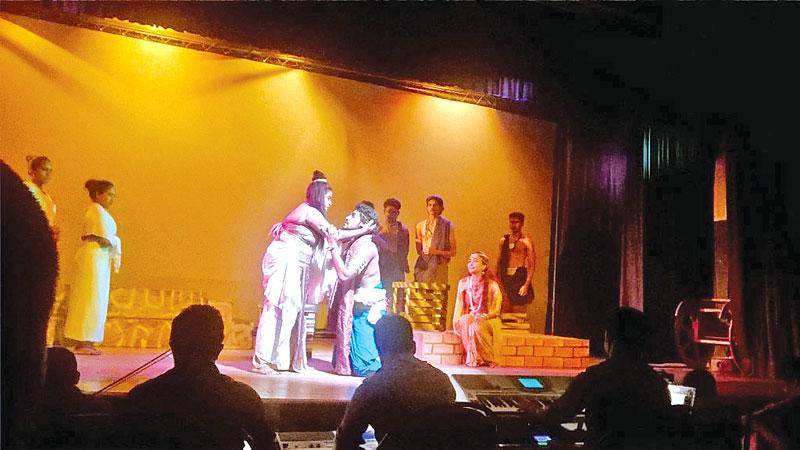
On 2 November the Punchi Theatre in Colombo saw a delightful work of theatre titled Giri Kuta Kashyapa, come to life. A Sinhala musical of a historical period drama genre, it is a directorial work of young theatre practitioner Akhila Sapumal scripted by Ariyawansa Ranaweera. It revolves around the assent of King Kashyapa to the throne after committing regicide, and the agony and trauma that wells within the family fold, as his mother, the queen of the slain King Dhathusena, damns her first born and his wife, for the grief caused her and the treachery done to a loving father.
Narrated through song and choreography it is a story of a king who found strength through belief in himself and the love of his loyal and devoted wife, to realise his vision of creating a wondrous abode, the glory celebrated as an enigmatic archaeological wonder today –‘Sigiriya’. The narrative goes into the discovery of the site, how the citadel is developed, how civil unrest and rebellion rose and paved the way for the king’s younger brother, Prince Mugalan to mount a retributive challenge to the throne, to avenge their father. It is in some sense, a ‘singing to life’ through theatre, a significant episode in the country’s history, the story of King Kashyapa, a story, orally passed down from generation to generation to this day.
Sapumal’s direction is one that builds on harnessing the impact of versified song, coupled with acting that subtly blends with the elements of the stylised and the realist forms. Simultaneously, there is the force of music that occupies a ‘voice’ of its own in this creation.
The importance of lighting, costumes and makeup in the production all come together to deliver a theatrical work which projects an impression of the epic theatre genre, albeit sans the multitudes of extras to ‘populate scenery’. Stagecraft was of a minimalist mode with impressionistic items, also being utilised at certain points in the narrative, such as, a large painting of a king which may have symbolised the larger than life image that lives of King Dhathusena in the minds of the people, including his son King Kashyapa, while also indicating how such an image could reflect the daunting effect in the psyche of King Kashyapa, as what he must consciously live up to, to become a king who will be exalted, and loom larger than life in the minds of his people, and also in ‘history’ itself.
Giri Kuta Kashyapa’s music direction by Lahiru Madavila, must be especially commended. The live orchestra that played at the foot of the stage fused instruments from the east and the west to create a schema of sound that had a ‘presence’ of its own. I saw even an item, as mundane as a clay water pot, deftly used to generate certain sound effects.
Giri Kuta Kashyapa can be applauded as a triumphant performance, a play which I believe will not fail to impress theatregoers, both young and old. I would unhesitatingly say, Giri Kuta Kashyapa will surely create a strong impression on any schoolchild to take an interest to learn about the glorious history of Sri Lanka, of our kings and their times, and the wonders they bequeathed to us, to treasure and proudly claim as our history and heritage.
